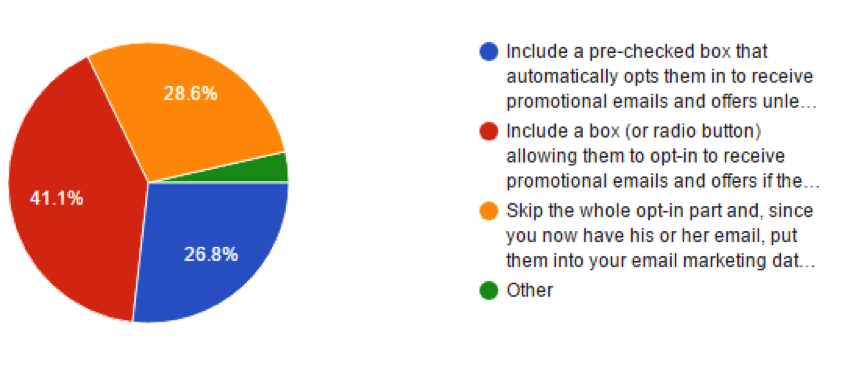Exclusive Poll Results: Email Opt-in Practices Following an Online Purchase
The following are the results of a recent poll by Marketing Democracy and Only Influencers: what are marketers opt-in practices following an Online Purchase:
As I wrote recently in my imediaconnection.com column, the subject of email subscriber acquisition has begun to lose the stigma that has surrounded it in polite conversation among email marketers and the vendors with whom they work. At Bill’s recent Email Innovations Summit in Las Vegas the topic was front and center in many of the panel discussions and email marketer presentations. Which is all for the good because the importance of maintaining the growth of one's an email subscriber database is greater than ever for email marketers. With flat or declining open rates, the only way to grow your business is to grow your subscriber list. And to grow it in a way that doesn’t have negative consequences on inbox delivery or worse.
During a recent conversation with a CEO friend of mine, the question arose as to how marketers deal with the email addresses they acquire during the course of an online purchase. These would be people who have not previously opted in to the brand’s email list, nor made a previous purchase. My CEO friend vehemently insisted that the vast majority of brands put those email addresses into their subscriber database and start mailing to them just as if they had actually subscribed to receive emails from that brand (through the home page, a pop-up box, etc.). Just as vehemently, I argued that most marketers would not place those email addresses into their databases unless asked for and received an opt-in during the purchase process.
When I broached the topic with Bill he suggested that Only Influencers and Marketing Democracy conduct a poll among email marketers to learn exactly how they do handle these email addresses, and what procedures they follow as part of the purchase We asked respondents tll us, “Which of the following steps do you take with a new customer making an online purchase at your website?” The four possible responses were:
- Include a pre-checked box that automatically opts them in to receive promotional emails and offers unless they uncheck the box. If they uncheck they receive no further emails other than transactional emails.
- Include a box (or radio button) allowing them to opt-in to receive promotional emails and offers if they check the box. If they don't opt-in they receive no further emails other than transactional emails.
- Skip the whole opt-in part and, since you now have his or her email, put them into your email marketing database and start mailing them.
- Other
When the poll was finished and the results were in, one thing was immediately clear.
I was right.

Just over 40% of marketers who answered the question responded that they ask for an explicit opt-in during check-out and would not add them to the list without getting that. Another 27% have a pre-checked box which, if left alone, will opt that customer into their email program. So 2/3’s of the email marketers who responded to the poll would not add the new customer to their email marketing database without either an explicit (I checked the box) or implicit (I didn’t uncheck the box) opt-in to receive emails. Less than a third take the email address and simply drop it into their email program. And the 4 % who checked “other”? They are actually very close to the 27% of implicit opt-in marketers. In those cases, and email opt-in is included in the Terms & Conditions a customer is asked to agree to prior to a purchase. Let’s face it, no one actually reads the T&C’s except your lawyers.
It would be an interesting experiment to examine the engagement patterns of the new email “subscribers” for each of the three approaches in our poll. Common sense would tell us that there would be a higher incidence of complaints and opt-outs among those in the “Skip the whole opt-in part” group than in the other two. And that the lowest incidence of complaints and opt-outs would be among the group that explicitly opt-in, with the last group falling somewhere between those two. That’s certainly what your delivery teams and the ISPs would have you believe. What it really comes down to is the old quality vs. quantity debate. Those marketers who put all the new customers’ email addresses into their database are playing the quantity game, while those asking for the explicit opt-in are going for quality. If higher inbox delivery of your campaigns is your goal (and it should be), it’s always a safer bet to go for quality over quantity. Quality at scale requires more work, after all.
But you didn’t get into email marketing because it’s easy, right?

 How to resolve AdBlock issue?
How to resolve AdBlock issue? 
